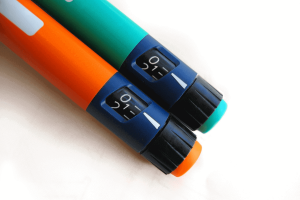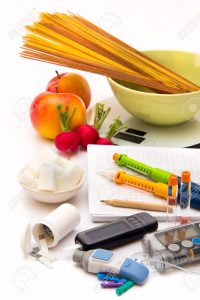Supermarket Savvy: Eating Healthy for Less
Healthy eating is an important part of diabetes care, and it starts at your local grocery store. It can be easier than you think to fill your cart with delicious, good-for-you foods–without breaking the bank. Follow these easy tips to help you shop supermarket savvy.
-
Stick to your list.
Save yourself valuable time and money making a grocery list before you go to the store. Start by making a list of meals that you would like to cook in the upcoming days, locate the recipes and look through your refrigerator/pantry to figure out which foods you have and what you need to buy. WebMD recommends making a list organized by aisle. Not only will this strategy save you time in the store but it will also help you make sure you’ve got all your food groups covered. It may also be helpful to online grocery shop, instead of going in-person. This strategy can make sticking to your grocery list a lot easier, and make the whole process easier. With a plan in place, you’re less likely to pile up on foods you don’t need or give in to those tempting–and often unhealthy–impulse buys. -
Clip those coupons.
Rooting through the newspaper may seem tedious and time-consuming, but you can score some serious money-saving deals with just a few coupons. Most stores will advertise a new fruit, vegetable, and protein on sale for the week. This is a great way to try new foods or incorporate new nutrients into your diet for a lot less. If clipping coupons is a little too old-schooled for you, then trying looking for coupons online. Search coupons for the grocery stores you’re planning on going to, visit coupons.com, or download the browser extension ibolla. Remember: Don’t buy something just because you have a coupon for it. To make the most out of each deal, stick to scoping out what you need. -
Check your blood sugar beforehand.
Grocery stores often prey on the hungry customer. Hypoglycemia, or low blood sugar, can make your mouth water as soon as you enter the store. Add that to rows of sugary treats stored at eye-level combined with the smell of freshly baked bread wafting from the bakery, and your next trip to the supermarket can quickly become a recipe for disaster. To avoid giving in to your growling stomach, try not to shop on an empty stomach. If you find your blood glucose is low before you head to the store, eat a small snack with some sugar and protein. Nibble on a couple of whole-wheat crackers topped with a slice of cheese or some peanut butter smeared on a few celery sticks to help keep those hunger pangs at bay and your resolve firm. -
Shop the perimeters.
The outer edges of the store are where you’ll find the healthiest, and most cost-saving foods to fill up your cart. Start in the produce section to load up on fruits and vegetables. Consider buying fresh herbs here as an inexpensive way to add new flavors to some of your favorite dishes. Instead of buying processed bread, try shopping at the bakery. You can find a wide variety of whole-grain loaves, rolls, and even crackers here. Spend some time shopping in the meat section. You can often find cost-saving deals on lean proteins such as chicken and turkey. Fresh fish, such as salmon and tuna, are full of heart-healthy fats and protein–both of which will keep you full and satisfied. Finally, in the freezer aisle, fill your cart with a few bags of mixed produce. Frozen berries are great for popping into a smoothie, and chilled vegetables make quick and easy dinners, such as stir-fries. -
Be adventurous.
Who says protein has to come from chicken or that apples and oranges are a main source of fruit? Instead of sticking to foods you know, browse the shelves for a variety of different items. Dips like hummus offer a new, interesting flavor while providing the same amount of protein as peanut butter. Instead of making a salad from lettuce, try crisp baby spinach or a bed of arugula for greens with a unique bite. To learn some fun, adventurous recipes click here! -
Know your nutrition facts.
Being able to speed-read nutrition labels will help you quickly determine which foods are good choices and which ones should stay on the shelves. According to the American Diabetes Association, shoppers should make sure the food has a filling serving size without too many calories or total carbohydrates. Sodium doesn’t affect blood glucose levels, but foods with too much salt can be just as bad for your cardiovascular health. The organization recommends choosing foods that have high fiber, protein, and healthy fat content. These are the options that will keep you full, satisfied, and healthy. -
Allow room for indulgence.
Everyone deserves the occasional treat. Grocery stores offer several options that allow you to indulge your sweet tooth, without doing damage to your blood sugar. If chocolate is your favorite, look for small, pre-portioned packs. Dark chocolate has less sugar and has been shown to boost heart health. If frozen treats are calling your name, look for sugar-free options. Popsicles and sorbets made with real fruit are a great way to end your meal on a light and sweet, but still healthy, note.
Summary
Healthy eating is an important part of everyone’s lives and it always starts at the supermarket! Keeping your coupons and shopping list handy is a great way to stay focused, while shopping the perimeters and being adventurous keeps things interesting. Don’t be afraid to indulge, but also make sure you keep your blood sugars in check so you don’t overbuy!




